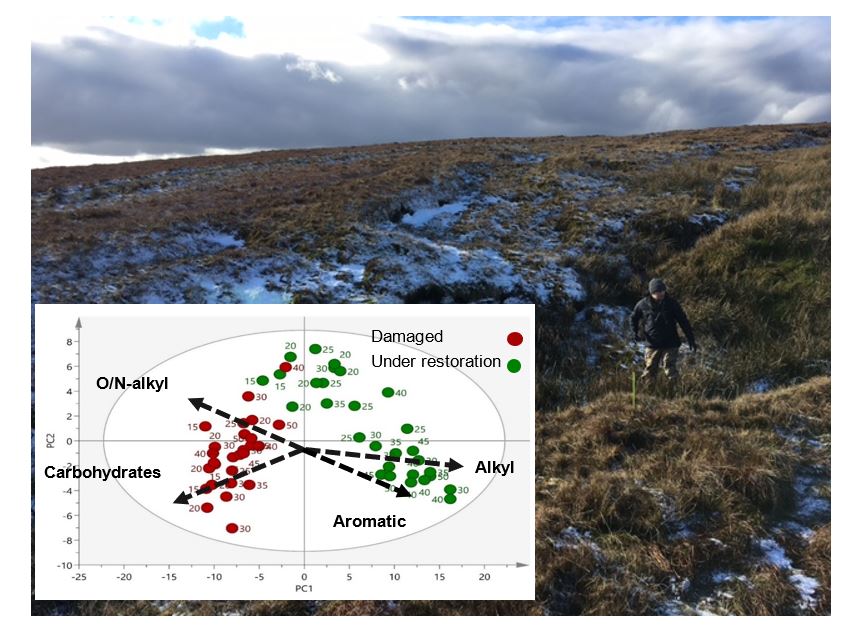Lead Supervisor: Chris Collins, Department of Geography and Environmental Science, University of Reading
Email: c.d.collins@reading.ac.uk
Co-supervisors: Nick Branch. Department of Geography and Environmental Science, University of Reading; Peter S. Jones, Lead Specialist Advisor – Peatlands, Natural Resources Wales; Chris Vane, Head of Organic Geochemistry, British Geological Survey

Figure 1. Peatland at Waun Fach – insert illustrates peat carbon chemistry affected by condition with carbon functional groups identified by Nuclear Magnetic Resonance (NMR)
There is global recognition of the value of peatlands because they provide high value ecosystem services. Their management and conservation is essential because of their wider environmental (e.g. biodiversity, carbon sequestration, water regulation), economic (farming, forestry), and cultural benefits (tourism and heritage). Despite ongoing efforts by the international scientific community to work in partnership with organisations and individuals to ensure that peatlands are maintained there is widespread recognition that the rate of damage and loss is accelerating due to poor controls, exacerbated by the effects of climate change. Peatlands located at higher elevation (blanket peat), naturally maintained by a combination of high precipitation, low temperature, impeded drainage (waterlogged, anaerobic conditions), geological properties and distinctive vegetation communities, are particularly threatened. This is because of their vulnerability due to the impact of adverse and increasingly variable weather conditions, higher rates of tourism and changing farming practices. What is urgently required is an effective toolkit for their management and conservation. The net benefits, in terms of climate change emissions alone, of restoring 55% of peatlands to near natural condition are estimated to have a present value of approximately £45-51billion[1]. Our research project will seek to address these challenges with a geographical focus on the Brecon Beacons National Park (BBNP) in Wales with close alignment to the recent Wales National Peatland Action Plan[2]. We believe the Park is representative of many upland peatlands in the UK and globally, and we will address the following fundamental questions:
The project addresses five key research questions:
1. What is the extent and rate of peatland damage and loss?
2. What characteristics increase the rate of loss?
3. How effective are current remediation measures?
4. What is the are the best metrics for national monitoring of peat condition?
Training opportunities:
This PhD offers excellent training opportunities from a multidisciplinary team. There will close liaison with our project partners Natural Resources Wales with a 3-6 month placement. This will provide a unique opportunity to understand and develop new skills in delivery of regulatory outcomes via environmental initiatives.
Specific skills the successful candidate will develop are:
· Coordination and engagement with farmers, tourists and policymakers – to determine peat restoration measures and adopted land use to support management decisions at the individual farm and landscape scale.
· Modelling the influence of peat status – to determine how remediation strategies can restore peat and thereby enhance cultural (tourism), provisioning (food) and regulating (water storage) ecosystem services.
· Design and maintenance of field and laboratory experiments
· Analytical techniques – spectral measurement of peat samples e.g. nuclear magnetic resonance (NMR), Fourier Transform Infra Red (FTIR) and RockEval pyrolysis.
Student Profile
This project would suit a student with a background in environmental chemistry, environmental/agricultural policy and soil science, and a keen interest in peatlands. Some knowledge of social science methodologies and science communication would be desirable, as well as field methods for the survey and characterisation of peatlands.
Funding Particulars
The project has CASE support from Natural Resources Wales.
References
[1] UK natural capital – Office for National Statistics (ons.gov.uk)
[2] National Peatlands Action Programme, 2020-2025 (cyfoethnaturiol.cymru)

